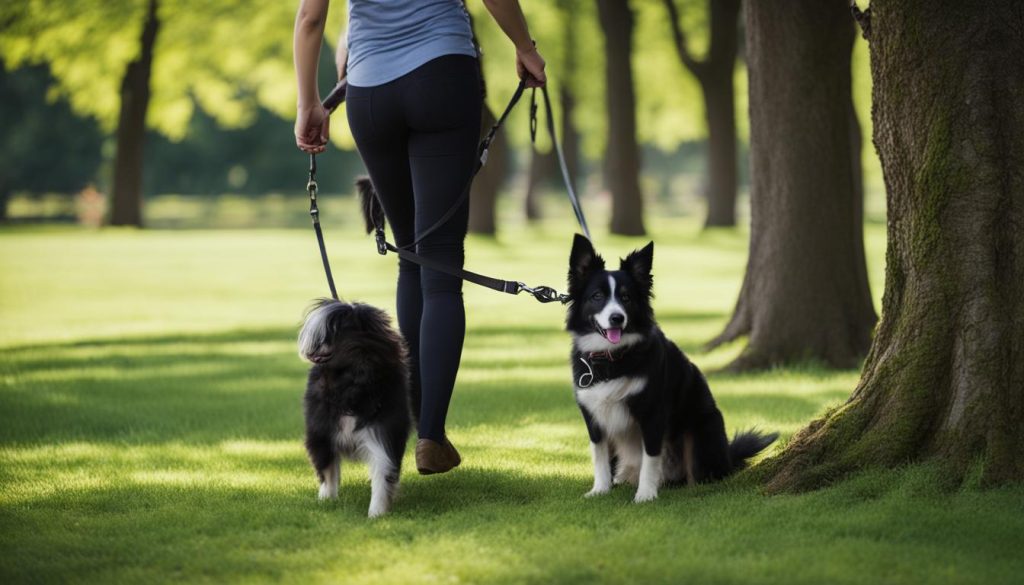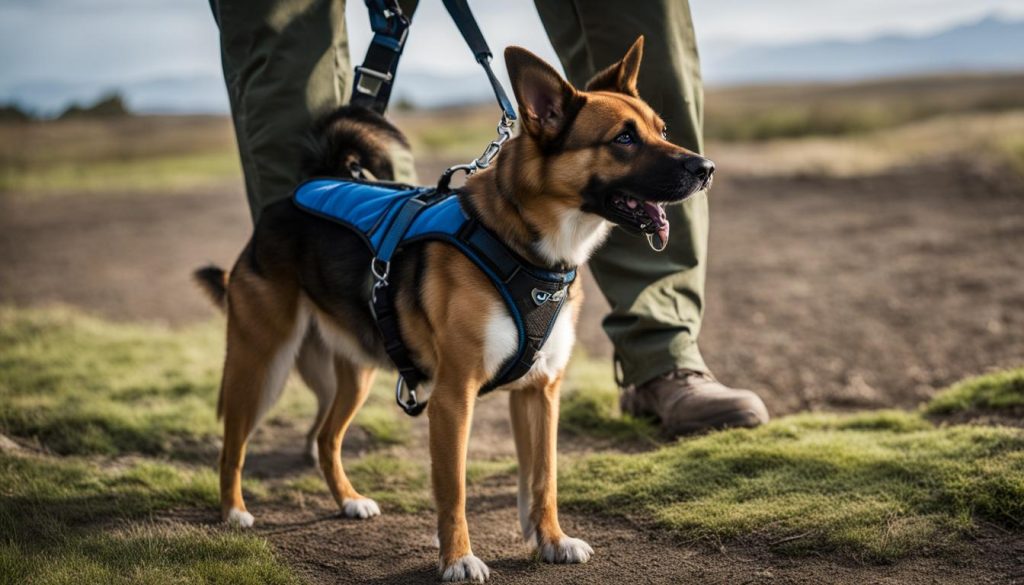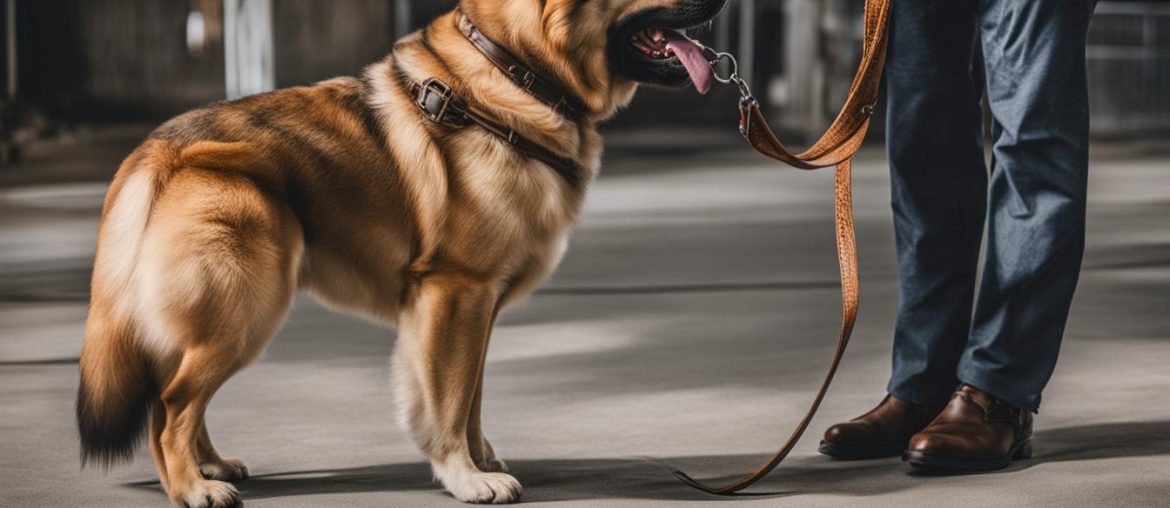Dogs pulling on their leash is a common problem that many pet owners face. It can be frustrating and make walks less enjoyable for both the dog and the owner. In order to effectively address leash pulling behavior, you should understand why dogs engage in this behavior in the first place.
There are several reasons why dogs pull on the leash. One of the main reasons is a lack of proper training. Dogs need to be taught how to walk on a leash without pulling. Without the right guidance, they may not realize that pulling is not the desired behavior.
Distractions can also contribute to leash pulling. Dogs are naturally curious creatures and may be tempted to chase after squirrels, other dogs, or interesting smells while on a walk. This can lead to pulling behavior as they try to get closer to whatever has caught their attention.
Additionally, some dogs may exhibit leash pulling due to aggression. They may be reacting to perceived threats or trying to establish dominance. Understanding the underlying reasons for leash pulling is key to addressing the behavior effectively.
Key Takeaways:
- Leash pulling is a common problem faced by many dog owners.
- Lack of training, distractions, and aggression can contribute to leash pulling behavior.
- Understanding the reasons behind leash pulling is key to addressing the behavior effectively.
- Proper training techniques and consistency are important in teaching dogs not to pull on the leash.
- Choosing the right equipment, such as a fixed-length leash, can aid in leash training.
The Importance of Proper Leash Training
Leash pulling can be a frustrating experience for both pet owners and their dogs. You should address leash pulling behavior as it can lead to safety concerns, such as the dog escaping or getting into altercations with other dogs. Training dogs not to pull on the leash is crucial for a harmonious walking experience. With the right techniques and tools, leash pulling behavior can be controlled and eventually stopped.
The Safety Risks of Leash Pulling
When dogs pull on the leash, they can put themselves and their owners at risk. Dogs may escape their leash and run into traffic or other dangerous situations. Additionally, leash pulling can lead to aggressive behavior, causing altercations with other dogs or pedestrians. By addressing and controlling leash pulling behavior, pet owners can ensure the safety of their dogs and create an enjoyable walking experience.

Techniques to Control Leash Pulling
Controlling leash pulling requires consistent and positive reinforcement training. One effective technique is to stop walking when the dog starts to pull on the leash and only resume walking when the dog relaxes and the leash is loose. Another technique is to change direction abruptly when the dog starts pulling, which teaches them to pay attention to their owner’s movements. Consistency and patience are key in teaching dogs proper leash manners.
Choosing the Right Equipment
The right equipment is essential in controlling leash pulling behavior. Opting for a fixed-length leash instead of a retractable leash provides more control and prevents the dog from pulling harder for more freedom. Additionally, using a harness instead of a collar can distribute the pressure more evenly and help control pulling. By choosing the appropriate equipment, pet owners can aid in their efforts to stop their dog from pulling on the leash.
| Techniques to Control Leash Pulling | Benefits |
|---|---|
| Stopping when the dog pulls | Teaches the dog that pulling leads to no forward progress |
| Changing direction abruptly | Redirects the dog’s attention and discourages pulling |
| Using a fixed-length leash | Provides more control and prevents the dog from pulling harder |
| Using a harness instead of a collar | Distributes pressure more evenly and helps control pulling |
By implementing these techniques and using appropriate equipment, pet owners can effectively control and eventually eliminate leash pulling behavior in their dogs. With consistency, patience, and positive reinforcement, walking with a well-behaved and obedient dog becomes an enjoyable experience for both the owner and their furry companion.
The Importance of Proper Leash Training
When it comes to walking our dogs, leash pulling can be a frustrating and challenging behavior to deal with. It not only makes the walking experience less enjoyable but can also pose safety concerns. That’s why please address leash pulling behavior and teach our dogs to walk nicely on a leash. Proper leash training is essential for both the well-being of our dogs and our own peace of mind.
One of the main reasons why leash pulling occurs is that dogs have not been taught how to walk on a leash correctly. They may have never been introduced to leash training, or their training may have been inconsistent. Without proper guidance, dogs can develop the habit of pulling on the leash because they have learned that it allows them to go where they want or get what they want.
To address leash pulling, use effective training techniques. Positive reinforcement is key in teaching our dogs to walk politely on a leash. By rewarding them with treats, praise, and attention when they exhibit the desired behavior of walking without pulling, we can encourage them to continue behaving that way. Consistency is also crucial, as dogs need clear and consistent cues from their owners to understand what is expected of them.
| Common Mistakes When Dealing with Leash Pulling | Proper Techniques for Leash Training |
|---|---|
| Pulling harder on the leash | Using positive reinforcement and rewards |
| Yelling or scolding the dog | Remaining calm and patient |
| Inconsistency in training | Consistent cues and clear expectations |
By avoiding common mistakes like pulling harder on the leash or scolding our dogs, we can prevent reinforcing the behavior of leash pulling. Instead, utilizing positive reinforcement, remaining calm, and being consistent in our training approach can help our dogs understand what is expected of them and encourage them to walk politely on a leash.
Understanding the Reasons Behind Leash Pulling
Dogs pull on the leash for various reasons, and understanding these reasons is crucial in addressing the behavior effectively. One common reason dogs pull on the leash is because they have learned that pulling gets them what they want. For example, a dog may pull to reach a certain spot or to interact with another dog. By pulling, they have been rewarded with the desired outcome, reinforcing the behavior.
Another reason dogs pull on the leash is that they are naturally faster than humans and want to explore their surroundings. Dogs have a strong instinct to investigate their environment and may pull on the leash to get closer to interesting scents or sights. This behavior is driven by their curiosity and desire for stimulation.
You should keep in mind that every dog is unique, and the reasons for leash pulling may vary. Some dogs may pull due to fear or anxiety, while others may do so out of excitement. By identifying the specific reasons behind leash pulling, pet owners can tailor their training techniques and address the behavior more effectively.

Factors Contributing to Leash Pulling Behavior
“Pulling on the leash can become a habit if not addressed early on. You should understand the underlying reasons behind this behavior and address them through consistent training methods.”
Factors such as lack of proper leash training, distractions in the environment, and a dog’s natural inclination to explore can all contribute to leash pulling behavior. Moreover, inconsistent training or inadvertently reinforcing the behavior can also perpetuate leash pulling habits in dogs. By identifying these contributing factors, pet owners can develop a tailored training plan to teach their dogs polite leash manners.
Next, in Section 5, we will explore effective training techniques to address leash pulling behavior and provide pet owners with practical strategies to stop their dogs from pulling on the leash.
Training Techniques to Address Leash Pulling
When it comes to leash pulling, have effective training techniques in place to address this behavior. By using positive reinforcement and consistency, pet owners can help their dogs learn to walk nicely on the leash without pulling. Here are some dog leash training tips to consider:
- Start Early: Begin leash training when your dog is between eight weeks and five months old. This is a critical period for learning, and starting early can prevent leash pulling habits from forming.
- Introduce the Leash Gradually: Let your dog become comfortable with the leash by gradually introducing it in a controlled environment, such as inside the house or in the backyard. This helps them associate the leash with positive experiences.
- Use Cues and Treats: Use verbal cues, such as “heel” or “walk,” to indicate the desired behavior. Reward your dog with treats and praise when they walk calmly on the leash without pulling. This positive reinforcement helps reinforce the desired behavior.
- Practice in a Controlled Environment: Before venturing outdoors, practice leash training in a calm and controlled environment. This allows your dog to focus on the training without distractions. As they become more comfortable, gradually introduce more distractions.
“Using positive reinforcement and consistency, pet owners can help their dogs learn to walk nicely on the leash without pulling.”
To put it simply, leash training takes time and patience. I recommend that you remain consistent in your training efforts and to be patient with your dog. Every dog is different, and some may take longer to learn than others. By using these training techniques consistently, you can help address leash pulling and enjoy pleasant walks with your furry companion.

Additional Tips for Leash Training Success
In addition to the training techniques mentioned above, here are a few extra tips to help you succeed in leash training your dog:
- Stay Calm: I recommend that you remain calm and composed when your dog pulls on the leash. Pulling back or becoming frustrated can escalate the behavior and make it more difficult to train.
- Be Consistent: Consistency is key in any training program. Set aside dedicated time each day to practice leash training, and use the same techniques and cues consistently.
- Seek Professional Help: If you’re struggling to address leash pulling or if your dog’s behavior is becoming a safety concern, don’t hesitate to seek professional help. A certified professional dog trainer can provide personalized guidance and support.
With these training techniques and tips, you can effectively address leash pulling behavior in your dog and enjoy walks that are both enjoyable and safe. Try to be patient, stay consistent, and provide positive reinforcement to help your furry friend become a well-behaved walking companion.
Choosing the Right Equipment for Leash Training
When it comes to leash training for dogs, selecting the right equipment is crucial. The type of leash, collar or harness used can greatly influence a dog’s behavior during walks. One of the first considerations is the length of the leash. Opting for a fixed-length leash, rather than a retractable one, can help dogs understand that pulling harder will not result in more freedom. It provides better control and prevents the dog from wandering too far or getting tangled.
Next, you should choose a collar or harness that is comfortable for the dog and does not cause any pain or discomfort. There are different options available, each serving a specific purpose. Flat collars are the most common and suitable for dogs with no specific issues. However, for dogs that tend to pull excessively, a harness or head collar may be more effective. These options distribute the pressure more evenly and discourage pulling behavior.
When selecting equipment, it is also important to consider the dog’s size, breed, and any individual needs. For example, small dogs may benefit from a harness that does not put strain on their delicate necks. Additionally, dogs with respiratory issues may require a different type of collar or harness that does not restrict their breathing. Overall, choosing the right equipment is essential in preventing excessive leash pulling and ensuring a comfortable walking experience for both pet owners and their dogs.

Comparison of Different Leash Types
| Leash Type | Pros | Cons |
|---|---|---|
| Fixed-length leash | Provides better control Prevents dog from wandering too far No risk of tangling |
Less freedom of movement for the dog |
| Retractable leash | Allows dog more freedom to explore Retracts easily for convenient storage |
Less control over the dog Potential for tangling or injury if not used properly |
| Harness | Distributes pressure more evenly Prevents strain on dog’s neck Discourages excessive pulling |
May require adjustment to prevent twisting Some dogs may not like the feeling of a harness |
| Head collar | Gives maximum control over dog’s head Discourages pulling behavior effectively |
Can cause discomfort if not properly fitted Dogs may need time to adjust to wearing a head collar |
Addressing Leash Pulling During Walks
When it comes to addressing leash pulling during walks, remain calm and avoid mirroring the pulling behavior. Instead, try employing techniques that can discourage leash pulling and encourage your dog to walk politely beside you. One effective method is to change direction abruptly when your dog starts pulling. By walking in the opposite direction, you signal to your dog that pulling will not get them where they want to go.
Another technique is to stop completely when your dog pulls on the leash. Standing still sends a clear message that pulling will not result in any forward progress. Once your dog stops pulling and the leash is loose again, you can continue walking. Consistency is key in reinforcing these techniques and teaching your dog proper leash manners.
It’s also essential to reward your dog for good behavior during walks. Positive reinforcement, such as giving treats or praise when your dog walks calmly beside you, can help reinforce the desired behavior. This will make your dog more likely to repeat the behavior in the future. Try to be patient with your furry companion, as it may take time for them to learn and improve their leash manners.

Example Walking Routine to Address Leash Pulling:
- Before the walk, ensure your dog is calm and not overly excited.
- Attach the leash to your dog’s collar or harness.
- Start walking and maintain a relaxed grip on the leash.
- If your dog begins to pull, stop walking and wait for them to relax or sit beside you.
- Once your dog is calm and the leash is loose, continue walking, praising and rewarding good behavior.
- Practice changing directions and stopping whenever your dog pulls on the leash.
- Stay consistent with your training and reward your dog for walking calmly beside you.
By implementing these techniques and establishing a consistent walking routine, you can effectively address leash pulling behavior and make walks more enjoyable for both you and your dog.
Seeking Professional Help for Leash Pulling Issues
While many pet owners can successfully address leash pulling behavior through consistent training and positive reinforcement, some cases may require the expertise of a certified professional dog trainer. Seeking professional help can be especially beneficial when dealing with older dogs or dogs with ingrained habits. Professional trainers have the knowledge and skills to assess the specific needs of both the pet owner and the dog, and develop personalized training plans to address leash pulling issues.
A certified professional dog trainer can provide guidance in behavior modification techniques and dog obedience training. They can assess the underlying reasons behind leash pulling and identify any additional behavior issues that may be contributing to the problem. Through one-on-one sessions or group classes, trainers can teach pet owners effective techniques for controlling leash pulling behavior and reinforce proper walking manners.
Working with a professional trainer also offers pet owners the opportunity to learn and practice effective communication skills with their dogs. Trainers can provide insights into canine behavior and teach pet owners how to establish a trusting and healthy relationship with their dogs. By partnering with a professional, pet owners can gain the confidence and knowledge needed to effectively address leash pulling and other behavioral challenges.
| Benefits of Seeking Professional Help for Leash Pulling Issues: |
|---|
| Expertise in behavior modification |
| Personalized guidance for pet owners and dogs |
| Teaching effective techniques for controlling leash pulling |
| Reinforcing proper walking manners |
| Insights into canine behavior and communication |
| Building a trusting and healthy relationship with dogs |
By seeking professional help, pet owners can overcome leash pulling issues and enjoy a more enjoyable and relaxed walking experience with their dogs. The expertise and guidance of a certified professional dog trainer can provide the necessary tools and support to address leash pulling effectively.
Meeting Dogs’ Physical and Mental Needs
When it comes to leash training, meet both the physical and mental needs of dogs. Regular exercise and play sessions are crucial to fulfill a dog’s physical stimulation needs, which can help prevent excessive leash pulling. Providing opportunities for dogs to explore their environment, either in a safely fenced area or on a long line, can also contribute to mental stimulation and reduce boredom.
Physical exercise can be achieved through activities such as brisk walks, jogging, playing fetch, or engaging in interactive games. These activities not only help burn off excess energy but also provide an outlet for dogs to release built-up excitement and maintain a healthy weight. Mental stimulation, on the other hand, can be achieved through engaging activities that challenge dogs’ problem-solving skills, such as puzzle toys or scent games.
By incorporating physical and mental exercise into a dog’s daily routine, pet owners can help prevent excessive leash pulling. A tired and mentally satisfied dog is more likely to exhibit calmer behavior during walks, making leash training more effective. To put it simply, a tired dog is a happy dog!
| Benefits of Meeting Dogs’ Physical and Mental Needs |
|---|
| 1. Reduced likelihood of excessive leash pulling |
| 2. Improved overall behavior and focus |
| 3. Enhanced bond and relationship between owner and dog |
| 4. Prevention of destructive behaviors resulting from boredom |
Overall, meeting dogs’ physical and mental needs is an essential aspect of successful leash training. By providing regular exercise and mental stimulation, pet owners can help create a calm and well-behaved walking companion. To put it simply, a satisfied and fulfilled dog is more likely to walk nicely on a leash and enjoy the experience as much as their owner does.
How Dogs Learn and Change Behavior
Understanding how dogs learn and change their behavior is essential in effectively addressing leash pulling issues. Dogs are highly trainable animals that respond well to consistency, positive reinforcement, and clear communication. By utilizing these principles, pet owners can help their dogs develop the desired leash behavior and overcome the habit of pulling.
Repetition and reinforcement are key to the learning process for dogs. By consistently practicing leash training techniques, dogs begin to understand the expected behavior and develop new habits. Positive reinforcement, such as treats, praise, and rewards, helps to reinforce the desired behavior and encourages dogs to continue behaving appropriately on the leash.
Building a trusting and healthy relationship with dogs is crucial in the training process. When dogs feel secure and connected to their owners, they are more likely to respond positively to training cues. You should establish clear communication and mutual understanding, ensuring that both the owner’s expectations and the dog’s needs are met during the leash training process.
| Training Tips | Benefits |
|---|---|
| Consistency | Helps dogs understand the expected behavior and reinforces new habits |
| Positive Reinforcement | Encourages dogs to continue behaving appropriately and strengthens the bond with their owners |
| Clear Communication | Establishes mutual understanding between the owner and the dog, facilitating effective training |
It is also important to consider the A-B-C method when addressing leash pulling behavior. This method involves analyzing the antecedent (what triggers the behavior), the behavior itself (such as pulling on the leash), and the consequence (what follows the behavior). Understanding the reasons behind leash pulling can help to develop effective training plans and address the behavior at its root cause.
By understanding how dogs learn and utilizing positive reinforcement techniques, pet owners can effectively control and modify leash pulling behavior. With patience, consistency, and a deepening bond between owner and dog, the journey to achieving loose leash walking becomes an enjoyable and successful experience.
Preventing and Addressing Leash Pulling in Different Environments
Preventing and addressing leash pulling in dogs is essential for a smooth and enjoyable walking experience. Whether you’re taking your dog for a walk in the park, on a busy city street, or in a crowded neighborhood, consistent training techniques can help curb excessive leash pulling behavior. By following the right dog walking techniques and creating a structured training routine, you can teach your dog to walk calmly on the leash in any environment.
One effective technique is to start leash training in a non-distracting environment, such as inside the house or the yard. Begin by introducing the leash gradually and rewarding your dog for desired behavior, such as walking without pulling. Once your dog is comfortable and responsive to leash training indoors, gradually transition to more distracting environments, such as quieter streets or parks. Consistency is key during this process, as it allows your dog to generalize the learned behavior across different environments.
Attending group classes for leash walking and life skills can also provide additional guidance and support for addressing leash pulling in different environments. These classes often offer controlled socialization opportunities, helping your dog learn to walk calmly around other dogs and distractions. With the guidance of a professional trainer, you can work on specific techniques suited for different environments and address any challenges that may arise during your dog’s training journey.
Overall, preventing and addressing leash pulling in different environments requires patience, consistency, and positive reinforcement techniques. By practicing leash training in a variety of settings and seeking guidance when needed, you can help your dog develop good leash manners and enjoy stress-free walks together.
| Benefits of Preventing Excessive Leash Pulling | Dog Walking Techniques for Leash Training |
|---|---|
| 1. Enhanced safety for both the dog and the owner | 1. Start leash training in a non-distracting environment |
| 2. Improved control during walks | 2. Gradually transition to more distracting environments |
| 3. Reduced risk of injuries or accidents | 3. Consistency is key in reinforcing desired behavior |
| 4. Increased opportunities for socialization | 4. Attend group classes for additional guidance |
Final Thoughts
To sum it up, addressing leash pulling in dogs requires a combination of proper training techniques and the use of appropriate equipment. Understanding the underlying reasons for leash pulling, such as learned behaviors and natural instincts, is crucial for developing effective training plans.
Choosing the right tools, such as a fixed-length leash and a comfortable collar or harness, can help in teaching dogs to walk nicely without pulling. Consistency and patience are key, as it may take time for dogs to learn and change their behavior.
Seeking the help of a certified professional dog trainer can be beneficial in more challenging cases or for older dogs with ingrained habits. Professional trainers can provide personalized guidance and expertise in behavior modification and obedience training.
By meeting dogs’ physical and mental needs through regular exercise, play, and mental stimulation, pet owners can contribute to successful leash training. With dedication and the right approach, pet owners can help their dogs overcome leash pulling behavior and enjoy pleasant walks together.
FAQ
Why do dogs pull on the leash?
Dogs pull on the leash for various reasons, including a lack of training, distractions, and aggression.
How can I stop my dog from pulling on the leash?
You can stop your dog from pulling on the leash by using positive reinforcement techniques, consistent training, and choosing the right equipment.
What are some common mistakes when dealing with leash pulling?
Common mistakes include pulling harder on the leash or yelling at the dog, which can actually reinforce the pulling behavior.
How can I understand the reasons behind leash pulling?
Understanding the reasons behind leash pulling involves recognizing that dogs may be pulling to reach a specific spot or interacting with other dogs, or simply because they are naturally faster than humans and want to explore their surroundings.
What training techniques can I use to address leash pulling?
Training techniques for leash pulling include starting leash training early, using cues and treats to reinforce good behavior, and practicing in a controlled environment before venturing outdoors.
What equipment should I choose for leash training?
Choosing the right equipment for leash training involves opting for a fixed-length leash instead of a retractable one and selecting a collar or harness that is comfortable for the dog and does not cause any pain or discomfort.
How can I address leash pulling during walks?
Addressing leash pulling during walks requires remaining calm, avoiding imitating the pulling behavior, and using techniques such as walking in the opposite direction or stopping completely to discourage pulling.
Should I seek professional help for leash pulling issues?
Seeking professional help for leash pulling issues can be beneficial, especially if the dog is older and has ingrained habits. Professional trainers can provide personalized guidance and expertise in behavior modification and dog obedience training.
How can I meet my dog’s physical and mental needs during leash training?
Meeting your dog’s physical and mental needs during leash training involves regular exercise and play sessions to provide physical stimulation, and allowing the dog to explore and interact with their environment for mental stimulation.
How do dogs learn and change their behavior?
Dogs learn through repetition and reinforcement. Consistency in training and using positive reinforcement techniques, such as treats and praise, can help dogs understand and change their behavior.
How can I prevent and address leash pulling in different environments?
Preventing and addressing leash pulling in different environments involves practicing leash training in non-distracting environments before gradually introducing more distractions, and attending group classes for additional support and guidance.






